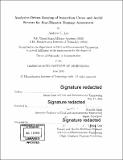Analytics-driven routing of inspection crews and aerial sensors for post-disaster damage assessment
Author(s)
Lee, Andrew C.(Andrew Choong hon)
Download1128184831-MIT.pdf (14.05Mb)
Other Contributors
Massachusetts Institute of Technology. Department of Civil and Environmental Engineering.
Advisor
Saurabh Amin.
Terms of use
Metadata
Show full item recordAbstract
Infrastructure networks such as natural gas pipelines and water systems are prone to failures from natural disasters, which result in huge societal and economic losses. To minimize these losses, inspection crews must rapidly identify failures (e.g., pipeline bursts, waterway blockages). However, infrastructure agencies often incur high costs and delays due to limited resources and diagnostic uncertainty about locations and types of failures. This thesis presents an analytics-driven network inspection approach that leverages data from fixed sensors and Unmanned Aerial Systems (UAS) to reduce diagnostic uncertainty, and determines optimal routing strategies for both ground crews and UAS. In our approach, the network is partitioned into smaller regions (subnetworks) based on the monitoring range of fixed sensors. We use sensor data and relevant physical features to assign priority inspection levels and predict failure rates for these subnetworks. We then leverage UAS to localize failures and incrementally update failure rates. The overall inspection is based on two routing problems: the Aerial Sensor Inspection Problem (ASIP), which guides UAS-based inspection of subnetworks; and the Prioritized Inspection Routing Problem (PIRP), which integrates pre-solved ASIP times and failure rates to determine crew routing strategies. For pipeline network inspection, we consider a set of monitoring locations that enable modeling of UAS platform and infrastructure topology constraints, and determine feasibility of UAS routes. To solve the ASIP for realistic situations, we propose an efficient set-cover-based heuristic. We show how to obtain crew routing strategies for large-scale network inspection by integrating ASIP solutions into the PIRP, and solving the resulting Mixed Integer Programming (MIP) problem. For drainage network inspection, we find that post-storm fixed sensor alerts are strongly correlated to the extent of damage in corresponding subnetworks. We present two formulations of PIRP: an adaptive stochastic dynamic program that considers prediction intervals of failure rates; and a non-adaptive certainty equivalent MIP that only accounts for mean failure rates. Solutions to these problems allow us to evaluate the value of integrating sensor data into inspection operations. We demonstrate the benefits of our approach using real data on network failures and inspections following Hurricane Harvey in 2017.
Description
Thesis: Ph. D., Massachusetts Institute of Technology, Department of Civil and Environmental Engineering, 2019 Cataloged from PDF version of thesis. Includes bibliographical references (pages 131-137).
Date issued
2019Department
Massachusetts Institute of Technology. Department of Civil and Environmental EngineeringPublisher
Massachusetts Institute of Technology
Keywords
Civil and Environmental Engineering.